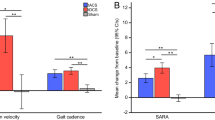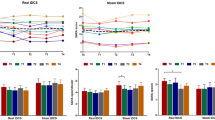Abstract
The excitability of the motor areas of the cerebral cortex is reduced in ataxia. Since transcranial direct current stimulation (tDCS) is a noninvasive neuromodulation technique able to increase the cortical excitability, we assessed the effect of anodal tDCS over the motor cortex in three patients with ataxia. A clinical evaluation, a video-taped SARA rating scale and a gait analysis with cinematic parameters, were performed pre- and post-sham and anodal tDCS cycle. The full cycle was composed by five consecutive constant current sessions of stimulation. Anodal tDCS (2.0 mA, 20 min, max current density: 0.0278 mA/cm2, max total charge: 0.033 C/cm2) was performed on the M1 area of the most affected side. The contralateral primary motor cortex underwent cathodal stimulation (2.0 mA, 20 min, max current density: 0.0278 mA/cm2, max total charge: 0.033 C/cm2). After anodal tDCS, gait analysis revealed an improvement of the symmetry of step execution and reduction of base-width lasting 30 days associated to patients’ perception of amelioration. No relevant changes were found after sham stimulation. Our results suggest tDCS can improve gait symmetry in patients with ataxia for a short-term period. Future researches are needed in order to standardize time, amplitude, and area of stimulation in order to reach a long lasting effect on cerebellar ataxia.
Similar content being viewed by others
References
Liepert J, Kucinski T, Tüscher O, Pawlas F, Bäumer T, Weiller C. Motor cortex excitability after cerebellar infarction. Stroke. 2004;35:2484–8.
Hore J, Flament D. Changes in motor cortex neural discharge associated with the development of cerebellar limb ataxia. J Neurophysiol. 1988;60:1285–302.
Manto M, Ben Taib NO. A novel approach for treating cerebellar ataxias. Med Hypotheses. 2008;71(1):58–60. Epub 2008 Feb 20.
Benninger DH, Mikhail L, Grisel L, Wassermann EM, Xiaobai L, Elaine C, et al. Transcranial direct current stimulation for the treatment of Parkinson’s disease. J Neurol Neurosurg Psychiatry. 2010;81:1105e1111.
Priori A, Berardelli A, Rona S, Accornero N, Manfredi M. Polarization of the human motor cortex through the scalp. Neuroreport. 1998;9(10):2257–60.
Nitsche MA, Liebetanz D, Lang N, Antal A, Tergau F, Paulus W. Safety criteria for transcranial direct current stimulation (tDCS) in humans. Clin Neurophysiol. 2003;114(11):2220–2.
Hummel F, Celnik P, Giraux P, Floel A, Wu WH, Gerloff C, et al. Effects of non-invasive cortical stimulation on skilled motor function in chronic stroke. Brain. 2005;128(Pt 3):490–9. Epub 2005 Jan 5.
Boggio PS, Ferrucci R, Rigonatti SP, Covre P, Nitsche M, Pascual-Leone A, et al. Effects of transcranial direct current stimulation on working memory in patients with Parkinson’s disease. J Neurol Sci. 2006;249:31–8.
Priori A, Hallett M, Rothwell JC. Repetitive transcranial magnetic stimulation or transcranial direct current stimulation? Brain Stimul. 2009;2(4):241–5. doi:10.1016/j.brs.2009.02.004. Epub 2009 Apr 3.
Yabe I, Matsushima M, Soma H, Basri R, Sasaki H. Usefulness of the Scale for Assessment and Rating of Ataxia (SARA). J Neurol Sci. 2008;266(1–2):164–6. Epub 2007 Oct 22.
Brunoni AR et al. Clinical research with transcranial direct current stimulation (tDCS): challenges and future directions. Brain Stimul. 2012;5(3):175–95. Epub 2011 Apr 1.
Lang N, Siebner HR, Ward NS, et al. How does transcranial DC stimulation of the primary motor cortex alter regional neuronal activity in the human brain? Eur J Neurosci. 2005;22(2):495–504.
Nitsche MA, Paulus W. Excitability changes induced in the human motor cortex by weak transcranial direct current stimulation. J Physiol. 2000;527(Pt 3):633–9.
Bindman LJ, Lippold OC, Redfearn JW. Relation between the size and form of potentials evoked by sensory stimulation and the background electrical activity in the cerebral cortex of the rat. J Physiol. 1964;171:1–25.
Purpura DP, McMurtry JG. Intracellular activities and evoked potential changes during polarization of motor cortex. J Neurophysiol. 1965;28:166–85.
Liebetanz D, Nitsche MA, Tergau F, Paulus W. Pharmacological approach to the mechanisms of transcranial DC-stimulation-induced after-effects of human motor cortex excitability. Brain. 2002;125(Pt 10):2238–47.
Nitsche MA, Fricke K, Henschke U, Schlitterlau A, Liebetanz D, Lang N, et al. Pharmacological modulation of cortical excitability shifts induced by transcranial direct current stimulation in humans. J Physiol. 2003;553(Pt 1):293–301. Epub 2003 Aug 29.
Ardolino G, Bossi B, Barbieri S, Priori A. Non-synaptic mechanisms underlie the after-effects of cathodal transcutaneous direct current stimulation of the human brain. J Physiol. 2005;568(Pt 2):653–63. Epub 2005 Jul 21.
Lang N, Nitsche MA, Paulus W, Rothwell JC, Lemon RN. Effects of transcranial direct current stimulation over the human motor cortex on corticospinal and transcallosal excitability. Exp Brain Res. 2004;156(4):439–43. Epub 2004 Jan 24.
Beaulé V, Tremblay S, Théoret H. Interhemispheric control of unilateral movement. Neural Plast. 2012;2012:627816. doi:10.1155/2012/627816. Epub 2012 Dec 6.
Oulad Ben Taib N, Manto M. Effects of anodal transcranial stimulation on the excitability of motor cortex in hemicerebellectomized rats. Congress of the European Federation of Neurological Societies. Eur J Neurol. 2007;14 Suppl 1:193.
Conflict of Interest
All the authors declare no conflict of interest.
Author information
Authors and Affiliations
Corresponding author
Rights and permissions
About this article
Cite this article
Pozzi, N.G., Minafra, B., Zangaglia, R. et al. Transcranial Direct Current Stimulation (tDCS) of the Cortical Motor Areas in Three Cases of Cerebellar Ataxia. Cerebellum 13, 109–112 (2014). https://doi.org/10.1007/s12311-013-0524-5
Published:
Issue Date:
DOI: https://doi.org/10.1007/s12311-013-0524-5




